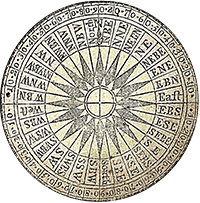Speaking of frontiersmen ..
Bland Ballard has been the subject of a number of biographical sketches. This post contains two similar but different accounts of Ballard’s life. The first excerpt from Lewis Collins’ History of Kentucky (Covington: Collins & Co., 1882) is the best summary of his life and times (with the exception of an incorrect date of birth), and appears to rely upon original interviews conducted with Bland Williams Ballard Jr.
Bland W. Ballard was born near Fredericksburg, Va., Oct. 16, 1761, and died in Shelby co., Ky., Sept. 5, 1853 – aged 92 years. His remains are interred in the State Cemetery at Frankfort.
The Ballards with others settled near the present Shelbyville in 1787, and here on 31 March of the following year they were attacked by Indians. The father, stepmother and several children were killed, but Ballard by a heroic defense, in which he was aided by his wife, succeeded in withdrawing the survivors.
In 1788, the Indians attacked the little Fort on Tick creek (a few miles east of Shelbyville), where his father resided. It happened that his father had removed a short distance out of the fort, for the purpose of being convenient to the sugar camp. The first intimation that they had of the Indians, was early in the morning, when his brother Benjamin went out to get wood to make a fire. They shot him and then assailed the house. The inmates barred the door and prepared for defense. His father was the only man in the house, and no man in the fort, except the subject of this sketch and one old man.
When the Indians broke into the house, his step-mother endeavored to effect her escape by the back door, but an Indian pursued her and as he raised his tomahawk to strike her, the subject of this sketch fired at the Indian, not, however, in time to prevent the fatal blow, and they both fell and expired together. The Indians were supposed to number about fifteen, and before they completed their work of death, they sustained a loss of six or seven. After this event, Bland stayed with some Mann family kinsmen.
In 1779, when Bland was 18 years old; he joined the militia; served in Col. Bowman’s expedition, May, 1779; in Gen. Clark’s expedition against the Piqua towns, July, 1780, where he was dangerously wounded in the hip, and suffered from it until his death; in Gen. Clark’s expedition, Nov., 1782, against the same towns; in 1786, was a spy for Gen. Clark in the Wabash expedition, rendered abortive by mutiny of the soldiers; in 1791, was a guide under Gens. Scott and Wilkinson; and Aug. 20, 1794, was with Gen. Wayne at the battle of the “Fallen Timbers.”
When not engaged in regular campaign, he served as hunter and spy for General Clark, who was stationed at Louisville, and in this service he continued for two years and a half. During this time he had several encounters with the Indians. One of these occurred just below Louisville. He had been sent in his character of spy to explore the Ohio from the mouth of Salt river to the falls, and from thence up to what is now the town of Westport. On his way down the river, when six or eight miles below the falls, he heard, early one morning, a noise on the Indiana shore. He immediately concealed himself in the bushes, and when the fog had scattered sufficiently to permit him to see, he discovered a canoe filled with three Indians, approaching the Kentucky shore. When they had approached within range, he fired and killed one. The others jumped overboard, and endeavored to get their canoe into deep water, but before they succeeded, he killed a second, and finally the third.
Upon reporting his morning’s work to General Clark, a detachment was sent down, who found the three dead Indians and buried them. For this service General Clark gave him a linen shirt, and some other small presents. This shirt, however, was the only one he had for several years, except those made of leather; of this shirt the pioneer hero was doubtless justly proud.
While on scout to the Saline Licks, on one occasion, Ballard, with one companion, came suddenly upon a large body of Indians, just as they were in the act of encamping. They immediately charged, firing their guns and raising the yell. This induced the Indians, as they had anticipated, to disperse for the moment, until the strength of the assailing party could be ascertained. During this period of alarm, Ballard and his companion mounted two of the best horses they could find, and retreated for two days and nights, until they reached the Ohio, which they crossed upon a raft, making their horses swim. As they ascended the Kentucky bank, the Indians reached the opposite shore.
At the time of the defeat on Long Run, he was living at Linn’s station on Beargrass, and came up to assist some families in moving from Squire Boone’s station near the present town of Shelbyville. The people of this station had become alarmed on account of the numerous Indian signs in the country, and had determined to move to the stronger stations on the Beargrass. They proceeded safely until they arrived near Long Run, when they were attacked front and rear by the Indians, who fired their rifles and then rushed on them with their tomahawks. Some few of the men ran at the first fire, of the others, some succeeded in saving part of their families, or died with them after a brave resistance.
The subject of this sketch, after assisting several of the women on horseback who had been thrown at the first onset, during which he had one or two single handed combats with the Indians, and seeing the party about to be defeated, he succeeded in getting outside of the Indian line, when he used his rifle with some effect, until he saw they were totally defeated. He then started for the station, pursued by the Indians, and on stopping at Floyd’s Fork, in the bushes, on the bank, he saw an Indian on horseback pursuing the fugitives ride into the creek, and as he ascended the bank near to where Ballard stood, he shot the Indian, caught the horse and made good his escape to the station.

Many were killed, the number not recollected, some taken prisoners, and some escaped to the station. They afterwards learned from the prisoners taken on this occasion, that the Indians who attacked them were marching to attack the station the whites had deserted, but learning from their spies that they were moving, the Indians turned from the head of Bullskin and marched in the direction of Long Run. The news of this defeat induced Colonel Floyd to raise a party of thirty-seven men, with the intention of chastising the Indians. Floyd commanded one division and Captain Holden the other, Ballard being with the latter. They proceeded with great caution, but did not discover the Indians until they received their fire, which killed or mortally wounded sixteen of their men. Notwithstanding the loss, the party under Floyd maintained their ground, and fought bravely until overpowered by three times their number, who appealed to the tomahawk. The retreat, however, was completed without much further loss. This occasion has been rendered memorable by the magnanimous gallantry of young Wells (afterwards the Colonel Wells of Tippecanoe) who saved the life of Floyd, his personal enemy, by the timely offer of his horse at a moment when the Indians were near to Floyd, who was retreating on foot and nearly exhausted.
During the period he was a spy for General Clark, he was taken prisoner by five Indians on the other side of the Ohio, a few miles above Louisville, and conducted to an encampment twenty-five miles from the river. The Indians treated him comparatively well, for though they kept him with a guard they did not tie him. On the next day after his arrival at the encampment, the Indians were engaged in horse racing. In the evening two very old warriors were to have a race, which attracted the attention of all the Indians, and his guard left him a few steps to see how the race would terminate. Near him stood a fine black horse, which the Indians had stolen recently from Beargrass, and while the attention of the Indians was attracted in a different direction, Ballard mounted this horse and had a race indeed. They pursued him nearly to the river, but he escaped, though the horse died soon after he reached the station. This was the only instance, with the exception of that at the river Raisin, that he was a prisoner. He was in a skirmish with the Indians near the Saline Licks, Colonel Hardin being the commander -the same Colonel Hardin who who fell a sacrifice to Indian perfidy in the northwest.
In after life Major Ballard repeatedly represented the people of Shelby county in the legislature, and commanded a company in Colonel John Allen’s regiment under General Harrison in the campaign of 1812-13. He led the advance of the detachment, which fought the first battle of the river Raisin – was wounded slightly on that day, and severely by a spent ball on the 22nd January. This wound, also, continued to annoy his old age. On this disastrous occasion he was taken prisoner, and suffered severely by the march through snow and ice, from Malden to Fort George.
As an evidence of the difficulties which surrounded the early pioneer in this country, it may be proper to notice an occasion in which Major Ballard was disturbed by the Indians at the spot where he then resided. They stole his only horse by night. He heard them when they took the horse from the door to which he was tied. His energy and sagacity was such, that he got in advance of the Indians before they reached the Ohio, waylaid them, three in number, shot the one riding his horse, and succeeded not only in escaping, but in catching the horse and riding back in safety.
_ _ _ _ _ _ _ _ _ _ _
The second sketch of Ballard’s life was written by Dr Lyman C. Draper. He begins with a description of Ballard… “Ballard says he has killed 30 to 40. Indians—was seven years representative of Shelby county, soon after Wayne’s Campaign, commencing in ’95 or ’96. Ballard was six feet, strong, raw boney man weighing upwards of 200; passionate and quick, and even over frank, but would speak what he thought regardless of consequences.”
Draper continues: Of Ballard’s service, we know that early in 1779 Ballard took part in Col. Bowman’s unsuccessful campaign against the Indians at Chillicothe. They returned to Virginia in the fall, but in the following spring young Ballard was again in Kentucky, and it is probable that his father and the rest of the family arrived at the same time.
The son’s early life was one of toil and hardship and an eager quest for danger. At the time, says his Eulogist, Col. Humphrey Marshall, when most Kentuckians were primarily concerned in getting land, young Ballard devoted himself to the cause of protecting the settlements from Indians. In 1781, he was with Gen. George Rogers Clark in the indecisive attack on the Pickaway towns in Ohio, where he was wounded. In the same year, in the disastrous battle on Long Run (in the present county of Jefferson), Kentucky, he escaped by killing an Indian and escaping on his victim’s horse. On the following day he was one of a party that renewed the fight and was again a survivor of a defeat. In 1782 he was once more with Clark in an attack on the Pickaway towns, which this time was successful. It was probably in the following winter that he married Elizabeth Williamson, a woman of great courage and the survivor of an Indian massacre at Lynn Station in September 1781, in which her father and one of her brothers was killed. In 1786 he served as a spy with Clark in the expedition against the Indians on the Wabash.
In a letter to Dr Lyman C. Draper, Judge Bland Ballard stated that “Maj. Ballard when asked how many Indians he has killed in one day, has often replied, “I killed six one morning before breakfast, & not a very good morning for the business.” Most likely he was referring to the Ballard Massacre. The next five years appear to have been uneventful, but on 5 April 1791 he was recommended to the Governor as Captain of the County Militia. In 1793 he joined Gen. Anthony Wayne, taking part in the campaign which virtually ended with the victory at Fallen Timbers, 20 August 1794.
In the year 1795 Bland W. Ballard appears in the Shelby county Tax Lists with the following property:
Ballard, Bland W. Jefferson/Harrods Creek/325
As already noted, he served five terms in the Kentucky legislature from 1795 to 1811. He fought at Tippecanoe, and in the following year, on the declaration of war against England, he organized and was made captain of a company in Col. John Allen’s regiment, subsequently attaining the rank of major. In the defeat at Raisin River (22 January 1813) he was twice wounded and made a prisoner, but escaped the Indian massacre that followed”
On his release after the War of 1812, Bland Williams Ballard returned to his farm. His first wife, Elizabeth Williamson, died 12 January 1827. He then married Dianah Matthews on 10 September 1833, who died 17 August 1835; on 28 October 1841, he married Mrs Elizabeth Weaver Garrett, who survived him.24 He died at his home on 5 September 1853, leaving many descendants in Shelby and Henry counties.
Welcome to “Sharing the Stories of History with Tim Mann”!
Meet Timothy A. Mann, a passionate historian born and raised in the heart of Shelby County, Ohio where Tim’s roots run deep in the rich soil of American history. As the author of articles and books, including “Frontier Miscellany Concerning the Miami County Ohio Militia,” “Colonel John Mann, His Kith and Kin,” and “Frontier Militia – The War of 1812,” Tim’s literary contributions have enlightened and inspired countless history enthusiasts.



